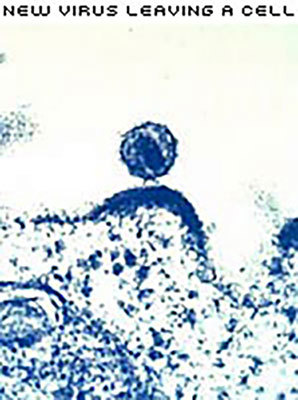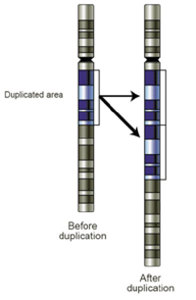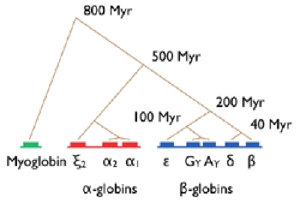
Where do new genes come from?
May 6, 2010

A high school student from California asks:
“Where do new genes come from?”
That's a great question that has a very interesting explanation. The short answer is that most new genes actually start off as mistakes in our DNA!
This might seem weird at first since mistakes are usually thought of as bad. But some are good.
Think about those old commercials where people with chocolate and peanut butter run into each other to create the first peanut butter cup. Or the 3M scientists who made a pathetically weak glue that turned out to be useful for Post-it notes.
A lot of mistakes can also happen to our DNA. The most common mistakes are small ones, sort of like a misspelled word. But some can be much larger.
Sometimes genes get left behind from invaders like viruses. And sometimes a big chunk of DNA gets copied twice.
In the worst case, these mistakes can lead to diseases like cancer. But just as with Reeses or Post-its, sometimes the mistakes can turn out to be good. In these cases, the DNA mistakes can ultimately lead to new genes.
For this answer, we’ll first review what genes are. From there, we’ll see how DNA mistakes can “accidentally” create new genes. Finally we'll go into some real-world examples to really drive the point home.
(If you want a quick refresher on DNA, genes, chromosomes, and the genetic code before we get into the nuts and bolts, click here for a quick refresher.)

Cells Recognize Genes as “Sentences” of DNA
Your genes are located in your DNA. But what's surprising is that only about 2% of your DNA codes for genes! So how does a cell know when a piece of DNA is actually a gene?
The answer is that all genes are written in a particular way in the DNA. It’ll help if you think of genes as “sentences.” Just like English sentences, DNA sentences need to follow certain rules.
In English, new sentences always start with a capital letter. Sentences also always end with a period, question mark or some other form of punctuation. They’re also made up of discrete words.
Genes follow rules in the same way. All genes are made up of “words” called codons. And just like a sentence starts with a capital letter, all genes start with a special “start codon” (the letters A-T-G). And, all genes end with a special stop codon (T-A-G, T-A-A, or T-G-A).
There are other “grammar” rules that genes follow, which I won’t get into here. But basically, as long as any piece of DNA follows those rules, your cell will treat that “gene-like” DNA as a real gene.
DNA is Always Changing
OK, so now we know how cells recognize genes in DNA. But if we get all our DNA from our parents, then where do the new genes come from?
The answer is that DNA is never copied perfectly from each generation to the next. There are always mistakes. And over time, these mistakes can sometimes result in a new gene.
At one extreme, mistakes can build up over the generations and turn a random piece of DNA into a completely new gene. The chances of this are obviously very low, but it does happen on occasion.
There are other kinds of mistakes that make it even easier to create a new gene. These mistakes involve changing existing genes into new ones.
Sometimes a virus leaves a gene behind, and our cells shape it for their own uses. Or two of our genes fuse together to create a new gene. Or one gene splits into two. Or our cells accidentally make two copies of a gene and shape one of them into a new gene. Or something else entirely. I won’t list all the possibilities, but this gives you a pretty good idea of the ways that new gene-like DNA can appear.
Of course, gene-like DNA isn’t a new gene. For the new gene to appear, the DNA changes we have been talking about have to keep happening to this gene-like DNA.
Basically, this DNA builds up changes over time. Most have little effect or are harmful, but a few are helpful. People with the helpful version will tend to do better than those without it and have more kids. Over time, the changed version of this gene-like DNA will become pretty common.
Then this cycle repeats itself over and over. In the end, you have a new gene that can do something that wasn't done before.
Useful Virus Genes
The easiest to understand way to get a new gene is when we steal one from a virus. It sounds crazy but it happens more often than you'd think.
The best example is a gene called syncytin, which used to belong to a retrovirus. Retroviruses aren't able to copy their own genes. Instead, they sneak their genes into our DNA, tricking our cells into doing all the work.
Sometimes, even after the virus is long gone, the virus genes get left behind in our DNA. And sometimes our cells turn them on by mistake. Don't worry though, these leftover genes are usually harmless. But they can provide a great canvas on which to make a new gene.
Syncytin started off as a key viral gene. It used to help the virus fuse with our cells (imagine a tiny soap bubble fusing with a big one). But then, it got left behind in our DNA.
By chance, some cells in the placenta started turning on the syncytin gene. With syncytin, some of the placenta cells started to fuse together. It turns out that this actually made the placenta work better!
As an interesting side note, this “virus stealing” has actually happened in many mammals. Sheep, rabbits, and mice also use virus genes to help their placenta. But, the viruses were specific to their species. That means that different mammals all stole the virus genes on their own!
So what's the take-home message? It's obviously difficult to come up with a new gene out of thin air. But stealing a “ready-made” gene from a virus can make things a lot easier.

Extra Gene Copies Can Turn into New Genes
Viruses aren’t the only places to get ready-made genes. You can also get them from your own DNA.
Sometimes your cell accidentally copies a piece of DNA twice. That leaves you with two copies of whatever genes were in that DNA.
You might be wondering whether a gene copy really counts as a “new” gene. After all, wouldn't the copies do the same exact thing?
We’re not finished yet! Remember that DNA is always changing over time, and that means genes can change too. The problem is that a gene’s job is usually very important. So, changes to the gene tend to be bad and might even lead to diseases like cancer.
But with an extra copy of the gene, things are different. As long as one of the copies keeps the old job, the other copy is “free” to change. Given enough time, what started off as an accident could turn into a new gene.

Hemoglobins: a Gene Family
One of the more famous genes out there is the hemoglobin gene. It carries oxygen to and carbon dioxide away from our cells. And mistakes in it can lead to problems like sickle cell anemia.
What a lot of people don’t know, though, is that we have ten hemoglobin genes! Each gene is important for a different time in our development or place in our body.
For example, you have different oxygen needs when you are developing inside of your mother's womb. There’s a gene for that. Your muscles have a different need for oxygen then the rest of your body. There’s a gene for that. And so on.
But this isn't how it always was. Hundreds of millions of years ago, in our distant ancestor, there was only one hemoglobin gene. It probably had a similar job as the hemoglobins we know today.
Most importantly, that one hemoglobin gene had to be a “jack of all trades.” It could specialize to work better in muscles, but that just means it wouldn't be as good elsewhere.
Then at some point, the hemoglobin gene underwent a gene duplication. With one copy as a backup, the other copy was able to specialize.
This happened at least ten times since then, and here we are now with ten hemoglobin genes! Each of these genes has a different function, and all of them can be traced back to the original hemoglobin gene millions of years ago.

There’s Much More!
We were only able to scratch the surface here. Making new genes is an incredibly rich field and one that I personally find fascinating. I have included some links below where you can learn even more about how new genes get made.

Author: Ed Chuong
When this answer was published in 2010, Ed was a Ph.D. candidate in the Department of Genetics, studying mammalian evolution and genomics in Julie Baker's laboratory. Ed wrote this answer while participating in the Stanford at The Tech program.
 Skip Navigation
Skip Navigation
